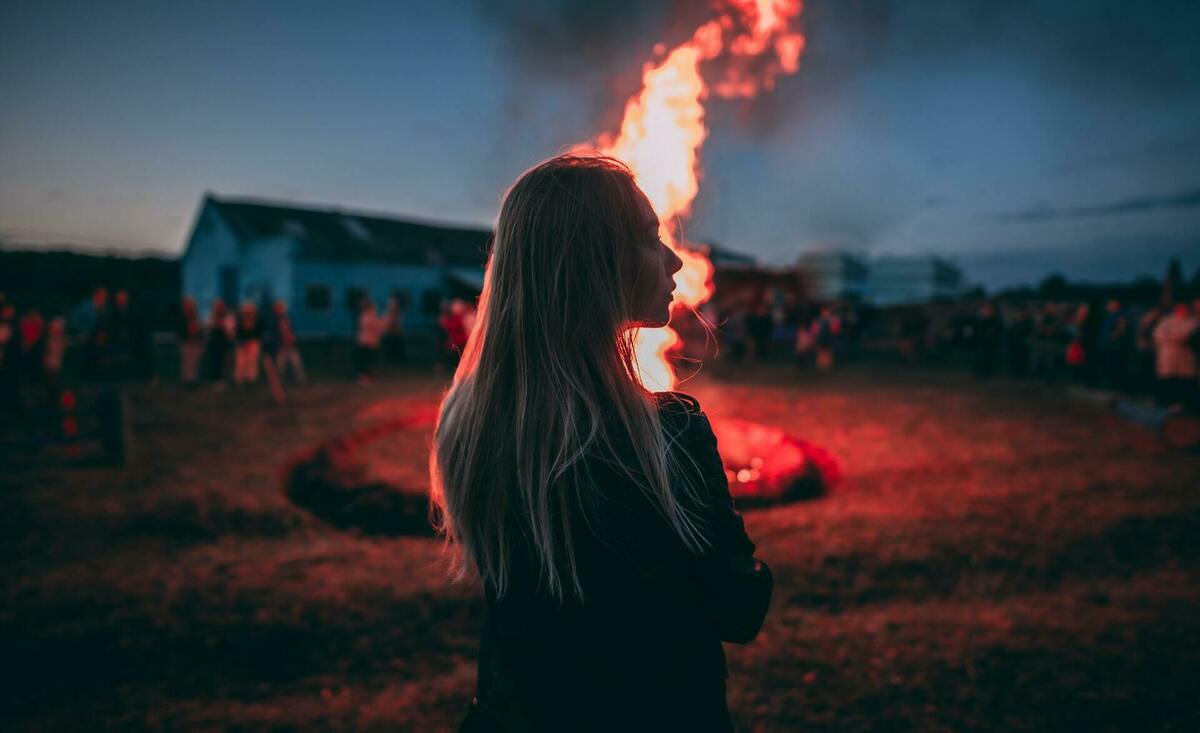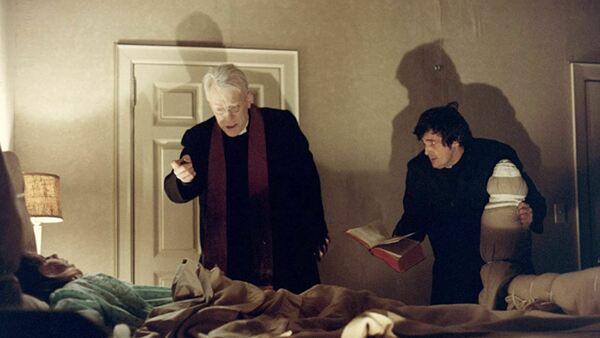Carrying the Fire in The Road
The dystopian world of Cormac McCarthy’s The Road is best summarized by the following lines from the novella: “Nights dark beyond darkness and the days more gray each one than what had gone before. Like the onset of some cold glaucoma dimming away the world . . .” It is a world of despair, of ashes, and coldness, and darkness, and the setting acts as a fable for where we sometimes imagine ourselves to be. The story is about a father and his son daily trekking along an unnamed road through this dangerous, post-apocalyptic landscape. He imagines them “like pilgrims in a fable swallowed up and lost among the inward parts of some gigantic beast.” The father describes everything as congealing gray, “barren, silent, godless . . . Everything paling away into the murk. The soft ask blowing in loose swirls over the blacktop.”
Perhaps when you worry about the state of things, you envision such a dark atmosphere. Personally, the landscape too often resembles my own heart after I succumb to cynicism about my work and life, the impossible tasks of doing things right, making a difference, satisfying others, or whatever lie overrides truths in those moments. Whether or not you have confronted such despair, coldness, or darkness, the novel shows us how to live through such a world. How are we to live? We are meant to carry the fire.
While the author never explicitly defines for the reader what it means to “carry the fire,” we receive several clues to the meaning of the phrase. The boy equates it with being the “good guys.” The bad guys are cannibals, those who have deteriorated from figuratively to literally devouring one another. The father tells the son that the fire is something invisible within him. And, when the father meditates on the nature of his son, he thinks, “If [the boy] is not the word of God, God never spoke.” As readers, we receive an image of light and heat in the midst of a cold, apocalyptic world. We see the father handing down to the boy what it means to live as human beings in this world where everyone around them has surrendered humanity.
In contrast to the father who carries the fire, the mother has given up hope. The mother in the story, only brought back by the father’s memories, shows us the life of a thin soul. The woman defends her choice to commit suicide: “They are going to rape us and kill us and eat us and you won't face it. You’d rather wait for it to happen. But I can't. I can't.” She reasons that the “bad guys” outnumber them, and therefore their destruction is inevitable. The father does not argue logic with her, for he cannot; they are viewing the same tragic facts of existence.
However, he sees their situation as participating in a different story. As he begs her to stay with them, she counters, “We’re not survivors. We’re the walking dead in a horror film.” It is her imagination of who they are and how they fit in the world that closes her off from hope. The story she inhabits has only room for despair. Although she knows the necessity of living for another person, as she tells her husband, her fear for herself overtakes that love for him and the boy, “As for me my only hope is for eternal nothingness and I hope for it with all my heart.”
Unlike the mother, the father prevails. And thus, so does the boy. Why? Because the father imagines that he and his son are “carrying the fire.” The story in which he dwells provides the space for hope. When the father speaks of the past, there is no false nostalgia; and when imagines the future, he does not create a utopia. As he warns the boy, “Listen to me, he said, when your dreams are of some world that never was or some world that never will be, and you're happy again, then you'll have given up. Do you understand? And you can't give up, I won't let you.” We carry the fire without falling into either error of nostalgia or futurism. Instead, carrying the fire is about the father bravely getting up each day and literally building a fire for his son.
The word “fire” is repeated 72 times in a rather short novel. Each day that they can, the father builds a fire for heat, to dry them, to cook with. They build a fire, stoke the fire, rekindle the fire, and watch the “labels char and curl,” or “The salt wood burn orange and blue in the fire’s heart [as] he sat watching it a long time.” In one sense, the daily building of the fire is a beautiful reminder of the necessity of the small tasks that comprise a life. The world needs the father and son to keep the fire going. We want to be those who do not neglect the anonymous, thankless work of building the fire and keeping it going.
Yet, every time the father builds a fire for himself and his son, the literal fire resonates with spiritual import. When the father describes “the ashes of the late world carried on the bleak and temporal winds to and fro in the void. Carried forth and scattered and carried forth again,” when he kneels in these ashes like a figure from the book of Job and raises his face to the “paling day,” praying and questioning God, the fire enters those moments as a signal of hope. In one instance, it is enough to realize that the boy will continue making fire, continue literal warmth and light in the world. More significantly, the fire within the boy is that fire of love that created us, as Catherine of Siena puts it. It is the fire of knowledge as a gift of the gods. It is the fire that “came from the holy flame,” as Statius says of Aeneid, the fire of the tradition itself handed down and embodied by those who live it.
In C.S. Lewis’s Narnia Chronicles, Eustace Scrubb learns about the spiritual meaning of things when he encounters a star—who speaks to him. He objects to this strange experience as part of the fantastical elements of Narnia. “In our world,” Eustace informs the star, “a star is a huge ball of flaming gas.” His definition is factually correct. But the star responds, “Even in your world, my son, that is not what a star is, but only what it is made of.” The factual reality of a thing does not encompass the whole of its reality. A human being may be described as an animal, a collection of compounds, and so forth, but there is much more to what we are. We must read not only texts but the world spiritually to see the fullness of things.
Novelist Frederick Buechner meditates on the literal and spiritual reality of fire in his vocabulary book Beyond Words: “Fire has no shape or substance . . . Yet there is no mistaking its extraordinary power,” he writes. “The fire that sweeps through miles of forest like a terrible wind and the flickering candle that lights the old woman’s way to bed . . . The power of fire to devastate and consume utterly.” There is a paradox to fire, a potential devastation, and a source of light. As a theologian, Buechner contemplates what fire looks likes in the pages of Scripture: “Fire is holiness and perhaps never more hauntingly than in that little charcoal fire that Jesus of Nazareth, newly risen from the dead, kindles for cooking his friends’ breakfast on the beach at daybreak.” The literal and spiritual reading of fire invites us into a deeper contemplation of what it means within The Road but also as a metaphor for education.
Reading Fire Across the Tradition
The image of “fire” did not merely pop into McCarthy’s mind; rather he inherited a tradition that employed fire with this literal and spiritual registry. In the early Church, argues the book Sanctified Vision, Patristic writers employed an intensive reading technique called “associative reading,” in which “specific words and images function more like intersections of forces than placeholders for determinate and fixed meanings.” Some postmodern critics relish this deconstructing of words, but that is not what the early Patristics were after. They believed that the play between words was meaningful, for God spoke creation into existence with words; Christ calls himself the Word; his laws are called his ten words, so all of this knowledge pointed to words being saturated with spiritual potency. We can read associatively the word “fire” across the tradition because McCarthy draws from that inheritance. By doing so, the word will become vibrant and illuminated for us in ways that invite us, too, to carry the fire.
In one of the Axial religions, Zoroastrianism, fire was revered as a purifying agent. The Greco-Roman world thought of fire as stolen from the gods for human beings—for hearth and kiln, but fire also became associated with knowledge. In the Hebrew Bible, God speaks through a burning bush and guides the Israelites through the desert by a pillar of fire. There is, in all these ancient stories, the resonance of fire as a divine emblem. It burns upwards and draws our eyes heavenward. The fire in the little boy is, as the father intimates, connected to the Word of God—“If he is not the word of God God never spoke.”
Fire is also associated with destruction. It burns down cities, empires, creation. At the conclusion of the war between the Greeks and Trojans, as fire is destroying the ancient city of Troy, the representation of an ideal civilization the hero Aeneas, witnessing the destruction of his home, rallies his soldiers with a rather despairing speech:
Brave hearts—brave in vain
If you are committed to follow me to the end—
You see how we stand. All the gods
Who sustained this realm are gone, leaving
Altar and shrine. You are fighting to save
A city in flames. All that is left for us
Is onto swords and die. The only chance
For the conquered is to hope for none.
Their cause sounds hopeless against the flames, the only recourse is death, and yet, instead of suicide, they draw their swords to fight to save the burning city.
We all know the story—a goddess prevents Aeneas from fighting alongside his men, for he must flee; his destiny is to establish the Roman Empire. As Aeneas exits the flaming city, he does so with his father Anchises on his back, who clutches the Roman gods, and with his son Ascanius holding his hand. Thus, we have the image of past, present, and future being salvaged from the apocalypse. The image of paideia and rebirth from out of the flames. They are carrying the fire—not the destructive fire, which brings the destruction of all they know, but the fire of past, present, and future. They imagine, by divine revelation, a new Troy that will arise from the ashes.
This is the presiding image at the conclusion of Ray Bradbury’s popular novel Fahrenheit 451. In that dystopian world, firemen burn books because knowledge is a dangerous thing. It frees people, making them difficult to control, hard to satisfy, hard to manipulate. However, some of the firemen revolt, memorizing the books before they burn them. They identify themselves by the books composed within their memory:
We are all bits and pieces of history and literature and international law, Byron, Tom Paine, Machiavelli or Christ, it’s here. And the hours late. And the war’s begun. And we are out here . . . We are model citizens, in our own way; we walk the old tracks.
Like the Trojans who fled the destroyed city and wandered to a new land, these rebel pilgrims must keep trekking on, hoping for a new world to be born. Like the father and son in The Road, these refugees are the “odd minority crying in the wilderness.”
While in the distance, the city burns, this group of renegade firemen gather around a fire to fry bacon for their meal, and they discuss the nature of a phoenix: “every few hundred years built a pyre and burned himself up, but every time he burnt himself up, he sprang out of the ashes [and] got himself born again.” Through the phoenix, the image of resurrection is associated with the fire. As the firemen of Fahrenheit 451walk out into the world, they determine to do one important thing, “We’re remembering. That’s where we’ll win out in the long run.” They are determined to “pass the books [that they have memorized] on to [their] children by word of mouth and let [their] children wait.” For the fire not to destroy civilization, these firemen have realized that they must imagine it as a cleansing fire, one that opens up the opportunity to start again.
For our imagination, there lies one of the many choices—to see fire as damning or purging, to accept the story in which we are carrying the fire or letting it consume us. At the height of Mount Purgatory, as Dante passes from the summit to the paradisal garden, he must walk through a fire, symbolizing a death to self and rising of his new life. James Baldwin’s memoir The Fire Next Time draws its title from the Lord’s covenant with Moses that he will not flood the earth again in the apocalypse but will bring fire. Apocalypse by fire may be destruction to some but resurrection to those who are purged by its flames. In the Bible, fire refers to both realities—damnation or salvation through refinement.
T.S. Eliot, the Christian convert, concludes his “Four Quartets” with the “choice of pyre or pyre—/ To be redeemed from fire by fire.” He writes in the middle of London being bombed by the Axis Powers, a city in flames. He looks to a spiritual way of reading his literal reality amidst fires: “We only live, only suspire/ consumed by either fire or fire.” The fire may mark the beginning or the end. One may experience the fire as “the only hope” while another feels it as “despair.” Eliot identifies this fire with his Triune God, called both Love and fire in the Bible: “God is a consuming fire” and “God is Love.” How might both be true?
In the fifth century, Theodoret of Cyrus explains that such seeming oppositions are not so at all. Rather, God, like the fire of the sun “hardens clay and melts wax, so some people under the influence of his mercy and love” become either hardened or softened by him. They become either destroyed and despairing because of the fire, or they become refined and renewed with hope. When we consider the formational power of literature, we are seeing this renewing power of fire, one that will sear us as it changes us.
Conclusion
Now, none of these examples are in The Road, but those with a collective cultural memory read fire in light of its associations across the tradition. If we read the image of the fire in The Road as a metaphor for education, to carry the fire is to imagine yourself in a story that began long before you and will continue after you, a story wider-reaching than your own worries or fears about the current apocalypse. To read the “fire” in this way keeps the tradition of spiritual reading alive; we are asked by the narrative to practice a way of reading patterns within the text, within the world, across time and place. Patterns are what grant meaning in a work of art. The image of carrying the fire, as it is repeated throughout The Road, gains significance and becomes a thicker and fuller image in our experience of the story. When we look outside the story for that image, we are reading the pattern in the story of the tradition. We are discovering meaning in this larger story. And, hopefully, we find a purpose that compels us to carry the fire forward.


